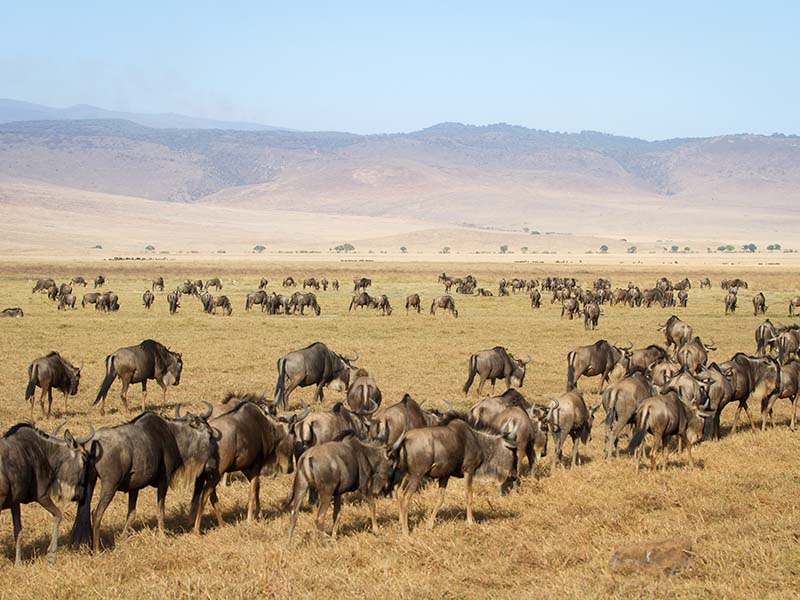- Home
- Safaris
- Hybrid tours
- Kilimanjaro
- Destinations
- Accommodations
- Travel info
- Our Company
Have you heard about Ngorongoro Crater? It's a natural wonder located in Tanzania and is home to a diverse range of wildlife. The crater is actually a large, unbroken caldera formed by the collapse of a volcano millions of years ago. Because of its unique geography, the Ngorongoro Crater is known as one of the most concentrated wildlife areas in Africa. You can spot a variety of animals here, including the African big five – lion, elephant, buffalo, leopard, and rhinoceros – as well as a large population of wildebeest, zebras, and hyenas. This natural haven provides an unparalleled opportunity to experience the beauty and diversity of African wildlife up close.
Ngorongoro Crater has a remarkable diversity of wildlife, making it a must-visit for nature enthusiasts. You can spot a wide array of animals including lions, elephants, wildebeests, zebras, and rhinos, all in their natural habitat. The variety of ecosystems within the crater creates the perfect conditions for different animal species to thrive, offering a unique and immersive wildlife experience for visitors.
Conservation efforts in Ngorongoro Crater are crucial to protect the diverse wildlife in the area. The Ngorongoro Conservation Area Authority (NCAA) plays a key role in managing and preserving the ecosystem. Among its conservation initiatives are anti-poaching patrols to protect the wildlife from illegal hunting and efforts to minimize human-wildlife conflict. The NCAA also supports community-based conservation programs to engage local communities in the preservation of the area's natural resources. These efforts are vital in maintaining the unique biodiversity of Ngorongoro Crater for future generations to enjoy.
Ngorongoro Crater is a large volcanic caldera that has significant geological importance. The crater was formed by the collapse of a volcano, and it is one of the most intact calderas in the world. It serves as a natural enclosure for a wide variety of wildlife and creates a unique ecosystem. The Crater is a haven for numerous species due to its diverse landscape, including grasslands, forests, and a freshwater lake. The geological features of the Ngorongoro Crater provide a glimpse into the Earth's history and the fascinating processes that have shaped our planet.
The best time to visit Ngorongoro Crater is during the dry season, from June to October. This is when the vegetation is less dense, making it easier to spot wildlife. However, it's essential to note that this period is also the busiest and most expensive. Another good time to visit is during the short dry season from January to February. The weather is still pleasant, and there are fewer tourists compared to the peak season. It's also a great time to witness the wildebeest calving season, a unique spectacle.

Safari experiences in Ngorongoro Crater can be truly exceptional. You’ll have the opportunity to see a diverse array of wildlife in their natural habitat, including lions, elephants, rhinos, and zebras. A guided safari can offer an up-close view of these magnificent creatures and the chance to witness their behaviors in the wild. As you traverse the crater, keep an eye out for the stunning landscapes and unique flora that make this area a one-of-a-kind destination for nature enthusiasts.
When visiting Ngorongoro Crater, you have a variety of accommodation options to choose from. Here are some of the popular options available in and around the crater:
These accommodation options cater to different preferences and budgets, allowing visitors to find the perfect place to stay during their Ngorongoro Crater adventure.
The Maasai tribe is one of the local tribes that reside near the Ngorongoro Crater. Visitors can engage in cultural interactions with the Maasai people by participating in activities such as traditional dance performances, visiting their villages, and learning about their customs and way of life. This provides a unique opportunity to gain insight into the rich cultural heritage of the Maasai and contribute to sustainable tourism in the region.
When visiting Ngorongoro Crater, keep in mind the following tips:
Ngorongoro Crater is a special place where wildlife thrives. It's home to a diverse range of animals and offers breathtaking views. Visitors can expect to see the Big Five as well as numerous other species in their natural habitat. The unique ecosystem of the crater provides a paradise for both the animals and the people who come to experience it.
Ngorongoro Crater is a large, unbroken volcanic caldera in Tanzania, renowned for its unique geography and as one of the most concentrated wildlife areas in Africa.
You can spot the African Big Five – lion, elephant, buffalo, leopard, and rhinoceros – along with wildebeests, zebras, hyenas, and a diverse range of other wildlife species.
The Ngorongoro Conservation Area Authority conducts anti-poaching patrols, minimizes human-wildlife conflict, and supports community-based conservation to protect the area's diverse wildlife.
The best times are during the dry season from June to October for wildlife spotting, and January to February for pleasant weather and the wildebeest calving season.
Options include lodges on the crater rim, tented camps inside and outside the crater, budget-friendly hotels and guesthouses nearby, and campsites for a wilderness experience.